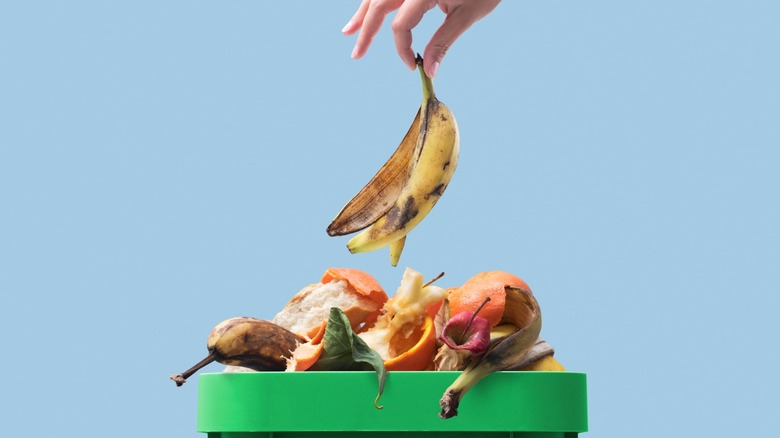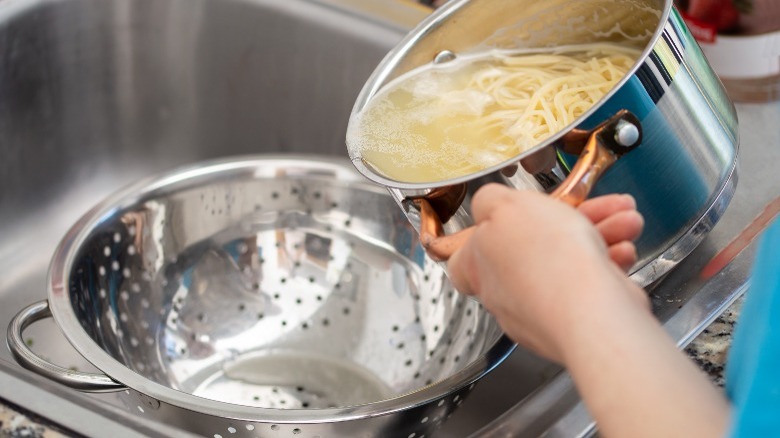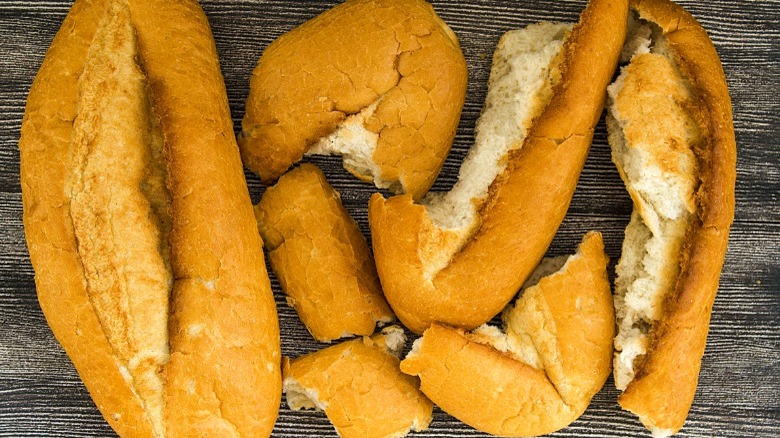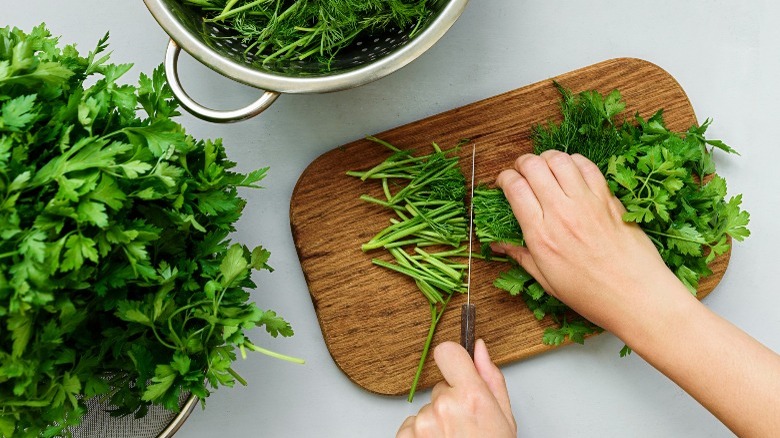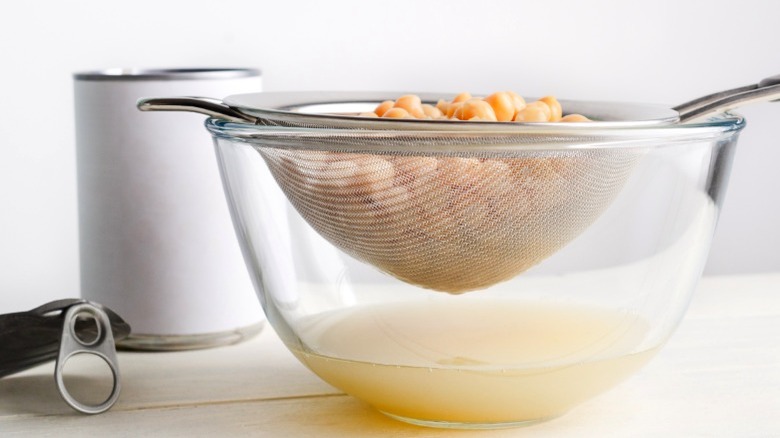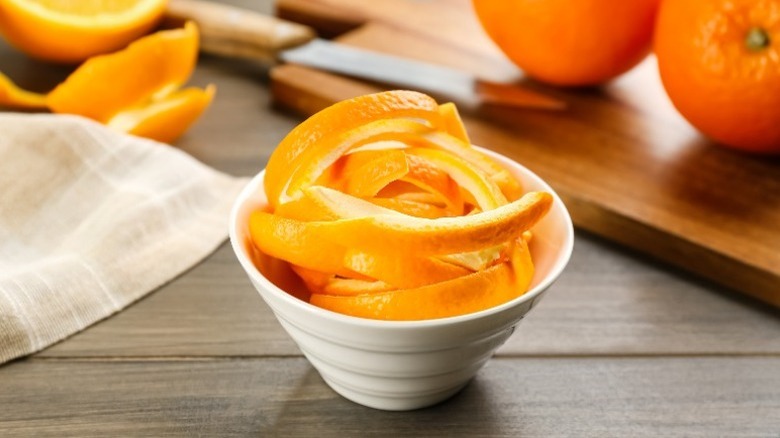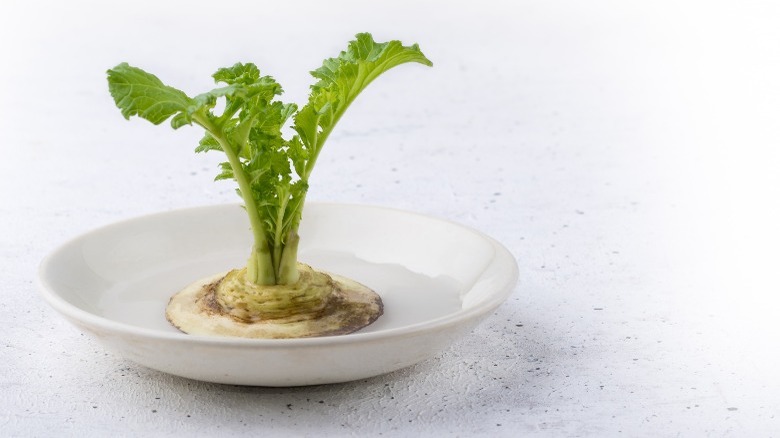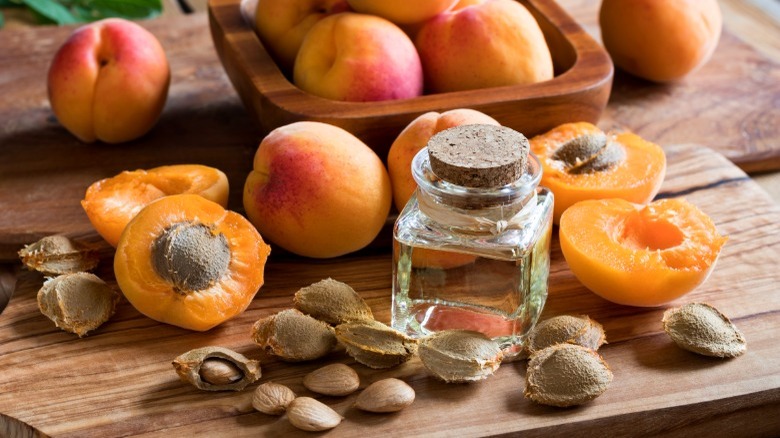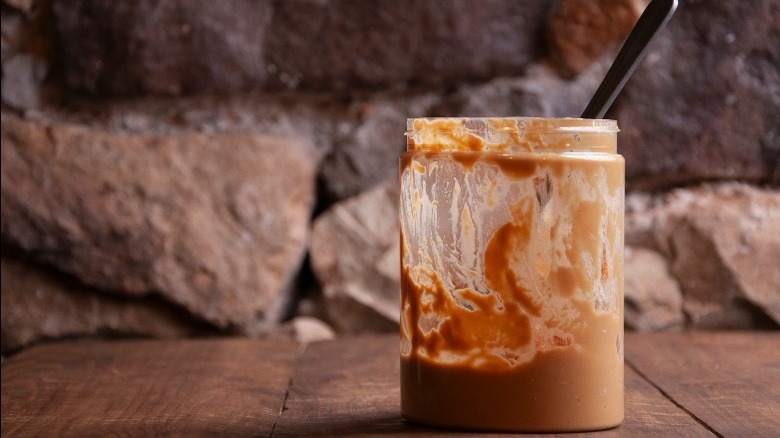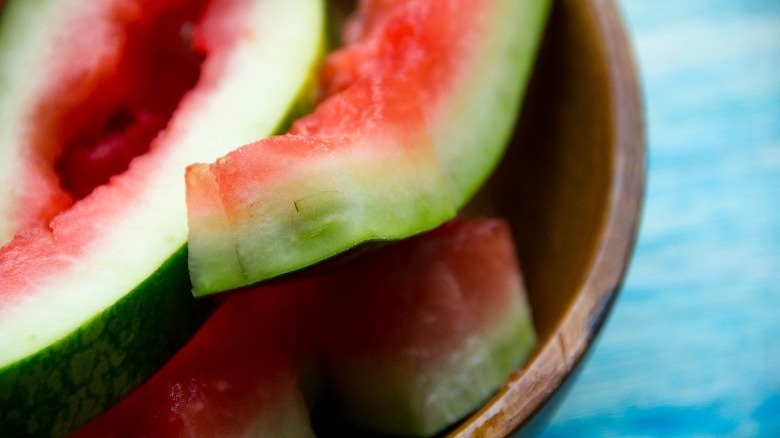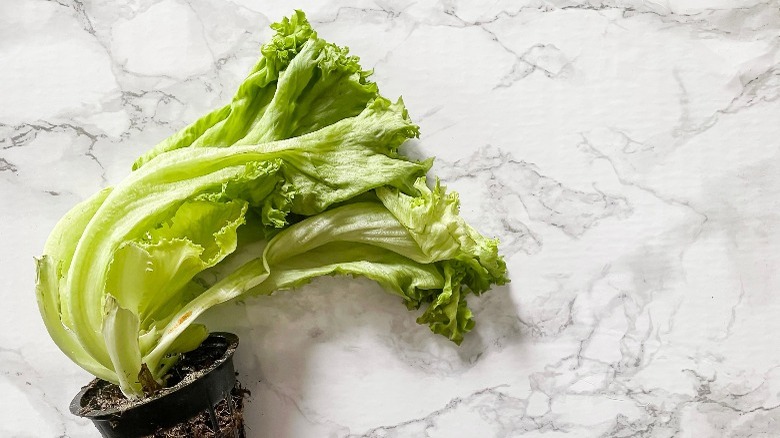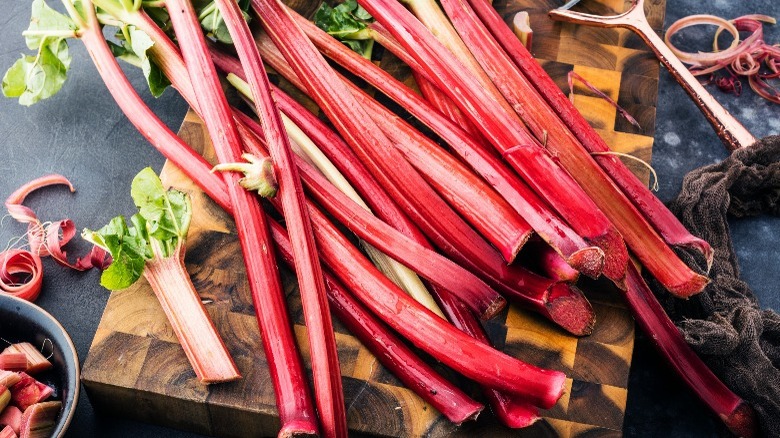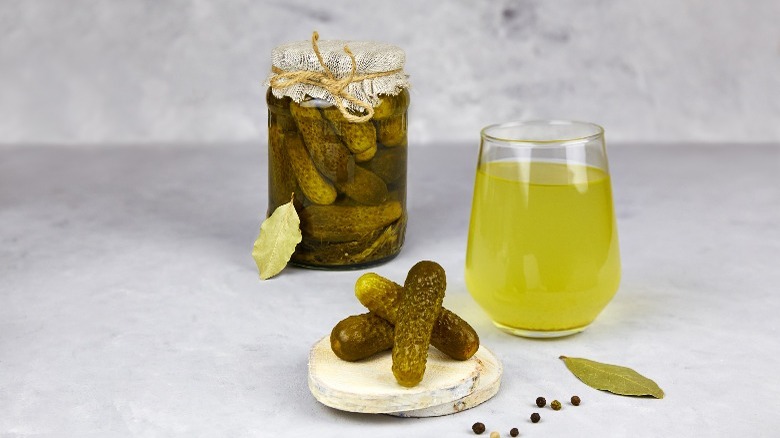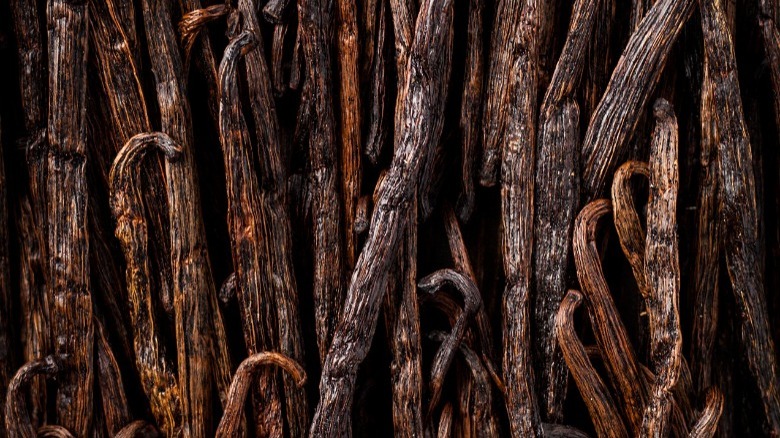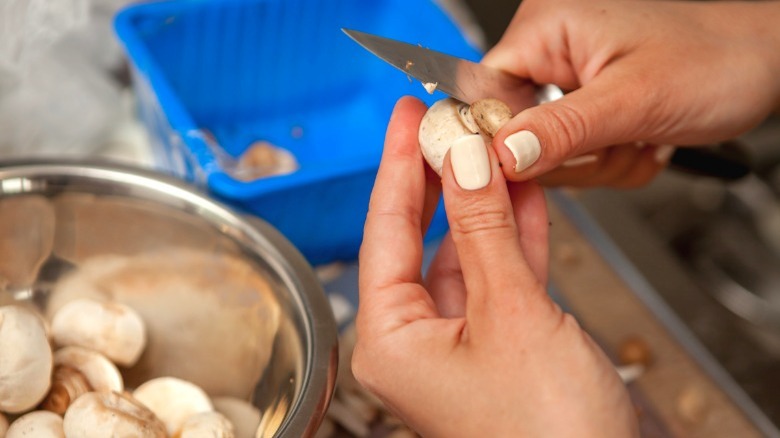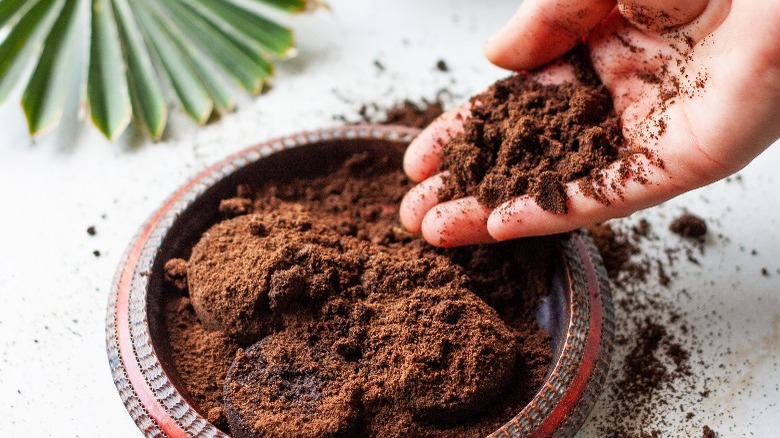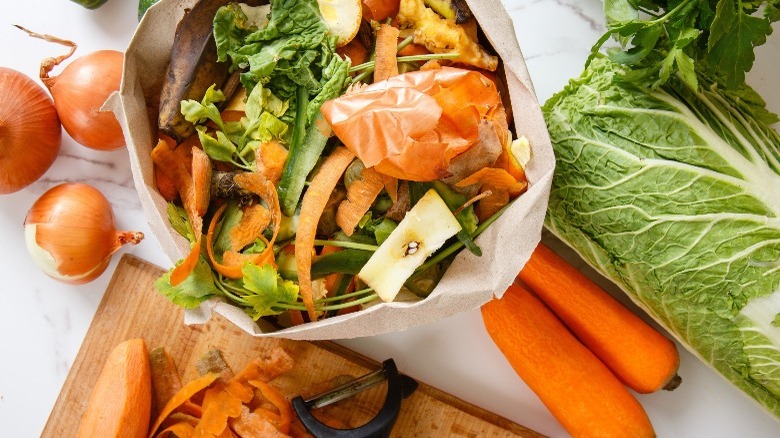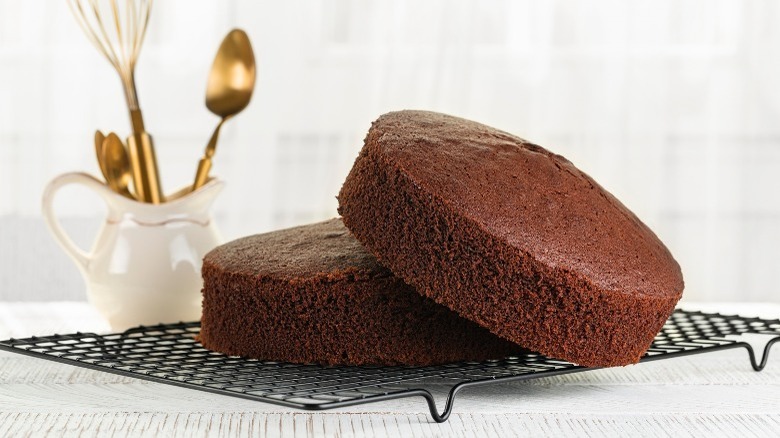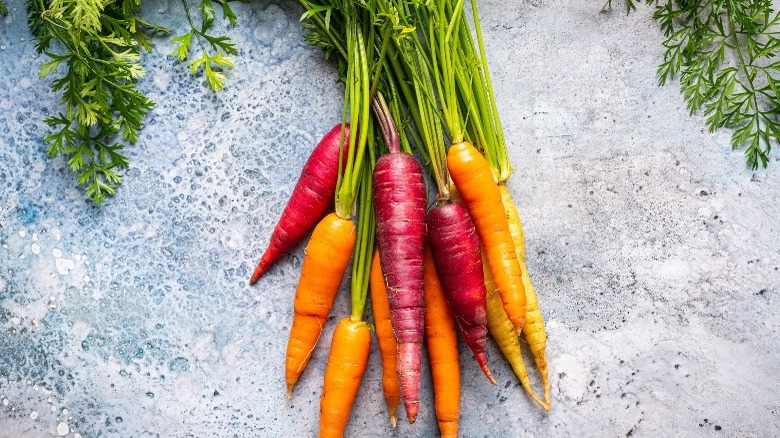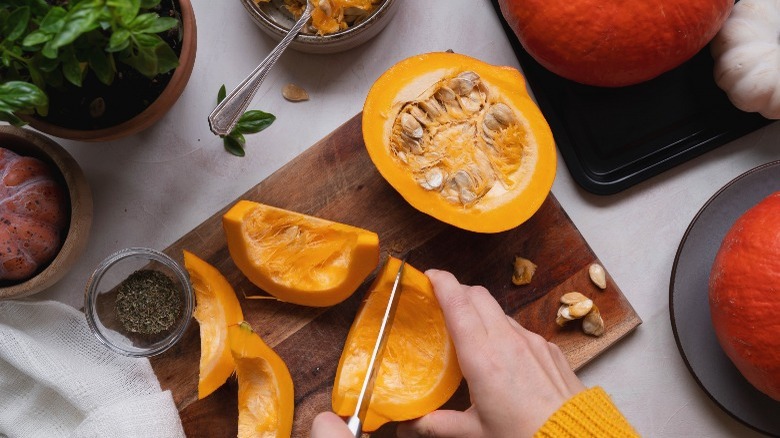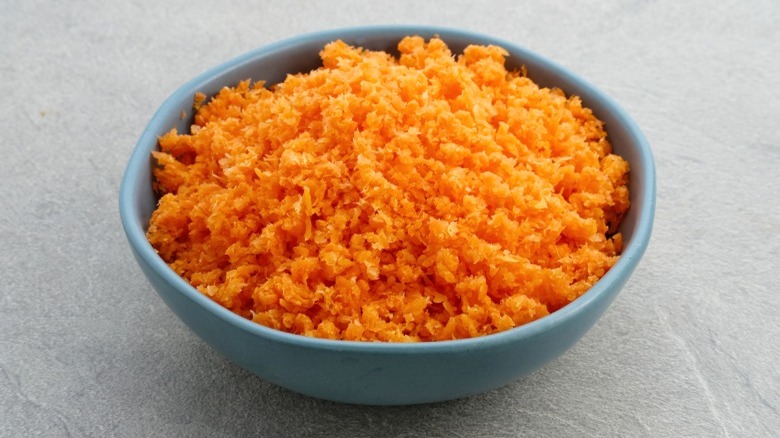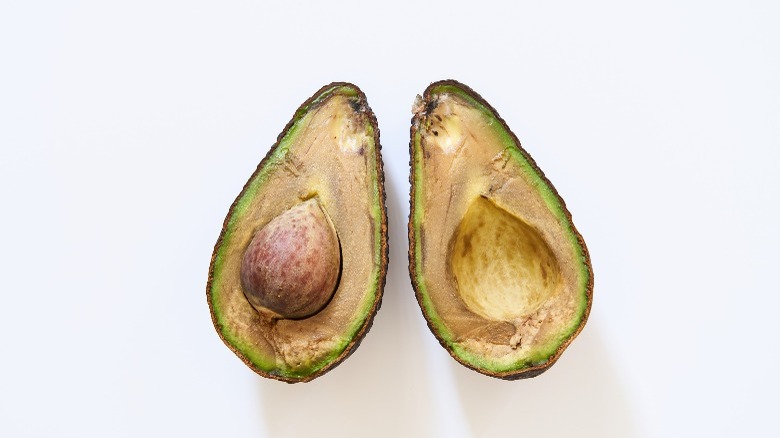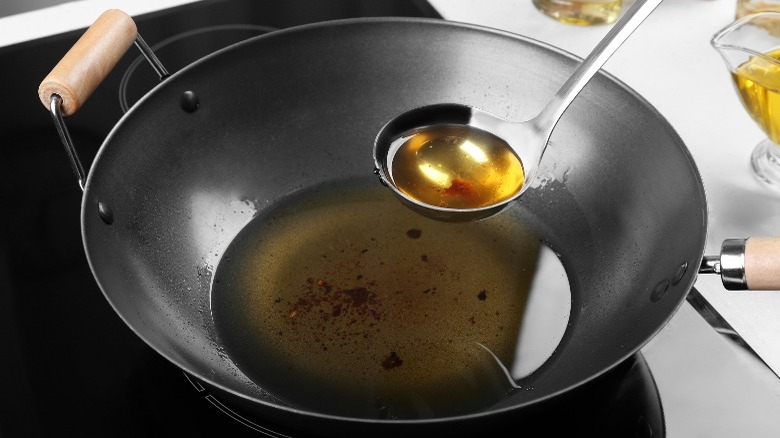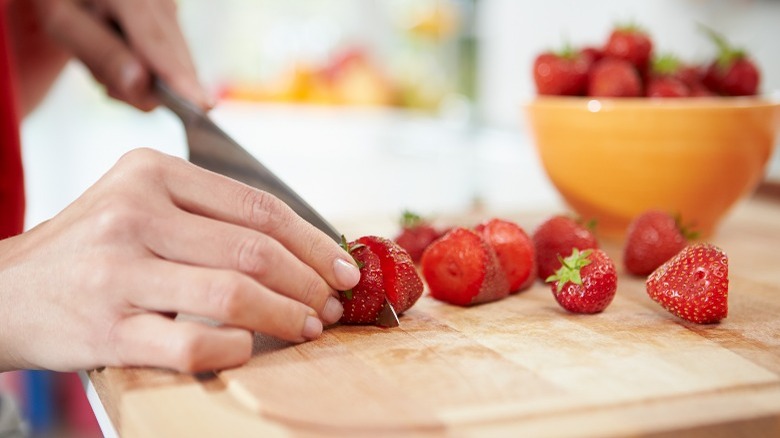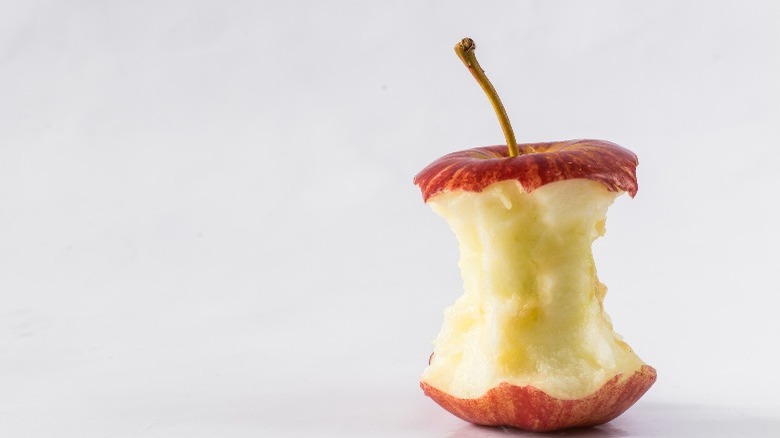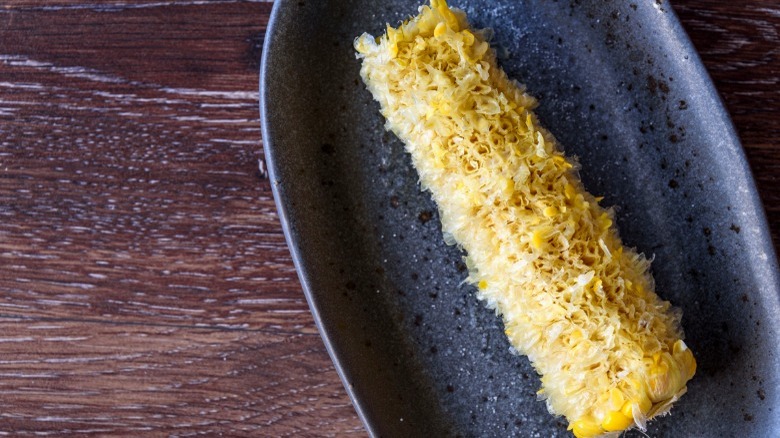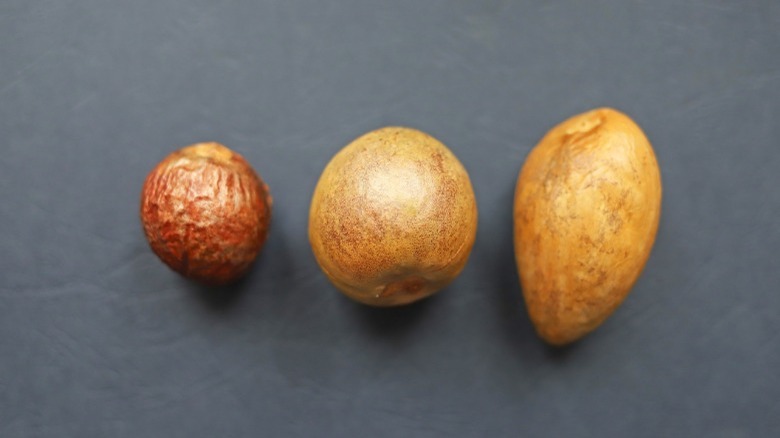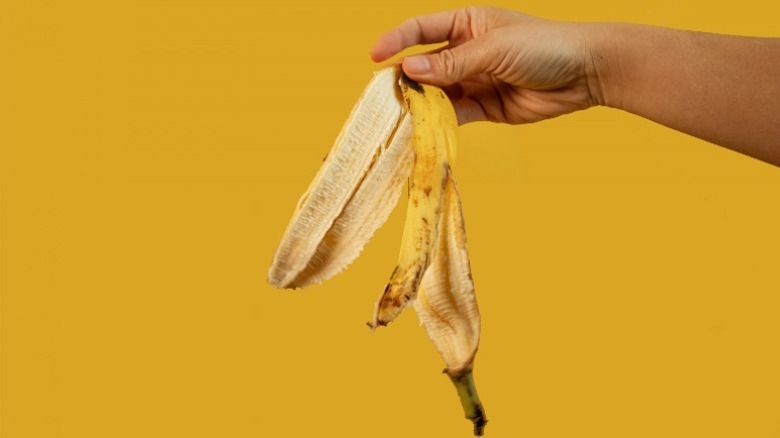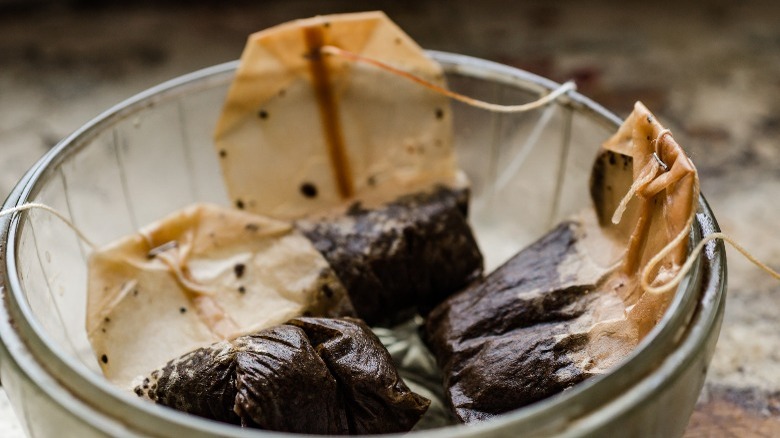29 Foods You Need To Stop Throwing Out
The ugly food trend is designed to help people embrace produce that is perfectly safe to eat but doesn't look great. You might have tried mindful grocery shopping and following a meal plan or dedicated to composting. However, you may still be unhappy with the amount of waste you're creating.
Food waste is a complex problem that doesn't have a simple solution. Considering that 40% of all food in the U.S. is tossed, it's evident that the current food system is unsustainable. Food loss occurs at every level of the supply chain, and over 60% of waste is created outside the home (via Feeding America). While we can't change the system overnight, we can try to manage our own food waste.
Changing our perspective can help accomplish this goal. Instead of seeing less-than-perfect produce, leftovers, and scraps as trash, let's see them for what they are — a versatile addition to our diets. Repurposing food is eco-friendly and saves money. Who knows, maybe upcycling food will become the dominant form of consumption, and browsing our list of foods you can stop throwing out may be an excellent first step.
Pasta water
Many people pour pasta water down the drain. Once you learn the value of this often discarded elixir (or "liquid gold"), there's no turning back. Water conservation aside, saving pasta water is a fantastic way to elevate sauces, soups, baked goods, and even drinks.
If it isn't more than a few days old, you can reuse pasta water to cook more pasta, rice, or anything boiled in plain water. Starch released as the pasta cooks causes the cloudy appearance. Together with a mild salty flavor, this thickens pasta sauce and is the secret to restaurant-worthy pasta dishes.
Additionally, you can incorporate pasta water into bread and pizza dough, substitute it for soup stock or use it to soak legumes. You can even use pasta water in cocktails or drink it alone.
Stale bread
Even for bread storage pros, there's a chance that it will go stale. Unless moldy, it's unnecessary to throw bread out. You can revive a stale loaf by wetting the crust and placing it in the oven or microwave, and there are dozens of ways to reuse stale bread. Turn the crust into breadcrumbs or transform sliced bread into French toast or bread pudding, for example.
Before the abundance of today's supermarkets, many recipes and techniques focused on using every bit of food. Italian cuisine has excellent examples of stale bread dishes, from salads mixing veggies, dry bread, and olive oil (panzanella) to ribollita (a bread soup). The same goes for strata, meatloaf, and stuffing, and stale bread is an excellent binder for meatballs or crab cakes, as well as a soup thickener. Don't forget croutons, a wonderful crunchy addition to soups and salads.
Herb stems
Typically, all parts of herbs are edible, and tossing herb stems is a major mistake. The stems of gentle herbs like cilantro or basil add a lovely crunch to salads and spreads. Falafel or tabbouleh rely on herbs, and you can maximize the flavor by using both leaves and stems. Mixed with stale bread, garlic, and crushed nuts, they can be turned into picada, an essential Catalan seasoning. If you keep a bag of unused stalks in the freezer, you can turn them into a chimichurri or pesto.
Unused stems can also flavor other things. Freeze leftover mint bits with water to make cocktail-ready ice cubes, add dill stems to fridge pickles, or use thyme stems for herb-infused vinegar. Tough stems of woodier herbs like rosemary can become skewers for grilling vegetables or be added directly to the grill to infuse food with herby smoke. Finally, leftover herb parts are excellent in homemade broth.
Aquafaba
For years, tossing the liquid from canned beans or chickpeas was expected: what else would you do with the oddly foamy, cloudy brine? After being discovered as a vegan egg white substitute for meringues in the mid-2010s, aquafaba was suddenly everywhere. While that's most common, there are many other sweet and savory uses for aquafaba.
Aquafaba works best in dishes where eggs take center stage. Think rich, creamy sauces like mayonnaise or aioli, tender and airy creations like chocolate mousse or marshmallow fluff, and almost any baked good. You can also use it in egg white cocktails, such as whiskey sour or gin fizz (via Cocktail Party).
Fruit peels
A lot of fruit is wasted both before and after reaching the consumer. Eating fruit skins is one way to combat fruit waste. Many fruits, such as apples, peaches, plums, pears, and grapes, do not need to be peeled. In fact, fruit skins contain fiber and nutrients and often comprise a significant portion of the fruit's total weight.
The peels have lots of culinary potential. You could make apple cider vinegar from apple skins and scraps or oven-baked chips with sugar and cinnamon. Citrus fruit peels are even more versatile. You could include whole rinds to make classic fruit preserves such as marmalade and candied peels or use the zest for citrus-flavored sugar or salt, or freeze it for later use in other dishes.
Vegetable stalks, pits, cuttings, and tops
Few food projects are as low-maintenance yet satisfying as regrowing plants from scraps. Popularized during the 2020 lockdowns, many people felt the need to ground themselves in food-based home projects. It remains a great way to save money and lower food waste.
Plants that regenerate in water are the easiest place to start. That includes green onions, carrots, beets, radishes, herbs, cabbage, celery, lettuce, bok choy, and others. For best results, Don't Waste The Crumbs recommends taller glasses for herbs and green onions and shallow bowls for lettuce and root veggies. You'll need just enough water to cover the root or bottom part and change it every few days to ensure no slime or mold forms.
You could also try regrowing entire plants in soil. According to Empress of Dirt, tuberous roots such as potatoes and yams and rhizomes like ginger and turmeric work best. Try herbs that can be regrown from stem cuttings and plants that produce seeds as well.
Stone fruit pits
The alternative name of drupes comes from the hard-shelled pits (stones) hidden at the core of cherries, apricots, peaches, and plums. These seeds are typically discarded and commonly believed to be poisonous. In truth, stone fruit seeds are protected by a cyanide-producing enzyme, but you would need to chew and ingest way more than a few to be affected (via National Capital Poison Center).
There are safe ways to use stone fruit seeds, and some of them are practiced industrially. Almond extract is made with water, alcohol, and almond oil. Technically stone fruits, almonds contain benzaldehyde, a compound regulating the intensity of what we identify as almond flavor. Considering all other stone fruits have it, all can be used to deliver that flavor, which is the strategy almond extract manufacturers employ. You can make your own almond extract or use whole peach pits to infuse vinegar with the subtle almond flavor. Alternatively, compost or plant pits.
Last bits of condiments and preserves
You've likely faced a ketchup bottle or old peanut butter jar with so little left it feels nearly impossible to get out. The next time you're in this situation, try approaching it with a different mindset. There are plenty of one-jar ideas that can make the most of the leftover bits.
All common condiments can be reused in creative ways. Use ketchup as a foundation for homemade BBQ sauce or marinade. Transform leftover mustard into a simple vinaigrette by placing vinegar, oil, and salt into the jar and shaking it vigorously. For sweet dishes, add hot milk to a Nutella jar and make hot chocolate, layer a parfait in an almost empty jam jar, or make overnight oats in a peanut butter container. You can also make a jam pan sauce for savory dishes by adding wine to a jam jar, shaking it vigorously, and then deglazing the pan with the mix.
Watermelon rinds
Watermelon can be eaten whole, even though it might not be evident to those who are used to discarding the rinds. However, they are totally safe to eat and have nutritional value. According to Healthline, watermelon rind is rich in vitamins A and C, as well as fiber.
Eating raw watermelon rind might be challenging for your teeth and stomach. Still, there are ways to get all that extra nutritional value while wasting less food. After you remove the green waxy skin, the white rind can be used in a variety of ways; pickled watermelon rind is especially popular in the South. You could also add it to smoothies, make rind candy or use it in curries and stir-fries.
Wilted greens
Greens are a nutritional powerhouse. They are also finicky in terms of storage: highly sensitive to temperature, humidity, and ethylene gas produced by other plants. If you make any storage mistakes or wait too long, wilting is inevitable, but you can salvage greens.
Soaking wilted greens in hot or iced water helps them reabsorb lost moisture in the crisper drawer. Another option is to cook your greens to wilt them even further. Cooked greens work really well in soups, scrambles, casseroles, and quiches. You can also add them to juices and smoothies, where their texture won't be bothersome. Finally, make sure to compost the slimy or rotting leaves before using the rest.
Old wine
If you store open wine for too long, it might go past the point of being enjoyable. Exposure to oxygen, light, heat, bacteria, and yeast affects the quality of wine. According to Wine Folly, light varieties shouldn't be stored for more than one to five days, and darker varieties no more than three to seven days. While unlikely to poison you, the experience will be subpar. There are ways to incorporate that wine into cooking. For example, you could use it in recipes that call for cooking wine or freeze the wine in an ice cube tray for later.
If your open bottle of wine turns rancid, turn it into wine vinegar. The process is fairly simple: mix the wine with unpasteurized vinegar, cover it with cheesecloth, and wait. You can start tasting it after a week and use it as soon as you're happy with the flavor.
Tough vegetable stems
Some vegetables are prized for their tender, flavorful, nutritious leaves, florets, and tips, while the tough stems are overlooked. While they may tough and fibrous, give those stems a second life in other dishes.
Kale stems and broccoli and cauliflower stalks can be used in a variety of ways. Eating them raw is still an option if you shred, chop, or mince them into chewable and digestible pieces and crunchy additions to salads or pesto. Raw cauliflower stalks can be processed into a fine mince for cauliflower rice, while an easy way to consume kale stems and broccoli stalks is to juice them. Pickling the tough stems is always an option, too. Finally, soups are a great way to use up leftover stalks and stems or freeze the scraps for vegetable broth.
Pickle juice
With a pickle craze sweeping the nation, there's no need to pour the humble pickle brine down the drain. The Food Institute attributes the surge in pickle popularity to reimagining flavor pairings and presentation. Theoretically, that could also help people see pickle juice as an ingredient with great potential.
Still considered a hangover remedy by some, pickle juice is a key to the pickleback shot. The Wall Street Journal compares the experience of chasing a shot of whiskey with pickle juice to drinking a Big Mac, and there are other pickle juice cocktails to enjoy.
Pickle juice could also replace vinegar, enhance flavors in tart soups, and marinate or tenderize proteins. The most wondrous thing is that a jar of reserved pickle juice can be used to make more pickles: just add chopped vegetables and leave the mix in the fridge overnight.
Spent vanilla beans
Some foods are so precious, rare, or expensive that you can't help but want to get the most out of them. Vanilla is one, as it is mainly produced in one country and requires labor-intensive farming. These factors directly affect its price and availability, and that's why most home cooks resort to store-bought vanilla extract that often relies on artificial flavoring. These cheaper alternatives are no match for the real thing. So whenever you get your hands on them, it's best to reuse spent vanilla beans.
You can infuse sugar and salt with vanilla to add a delightful flavor to drinks, baked goods, and oatmeal. For a subtle vanilla flavor, let the pods sit in the sugar. If you like an intense flavor, blend them with sugar or salt. The pods can also be used to make your own vanilla extract.
Mushroom stems
Mushrooms are an affordable, versatile ingredient packed with umami. While some, like cremini, are tender and can be consumed whole, others, such as shiitake or trumpet, have tougher, chewier stems that are usually chopped off. Removing the stems makes sense, but they can be used in multiple ways.
Shiitake mushroom stems, for instance, can be cooked longer and come in handy for a rich broth. Mushroom enthusiasts infuse alcohol with them or grind their dehydrated fungi leftovers into powder, which can add an umami boost to any dish.
While you can't stuff mushroom caps without removing the stems, you can incorporate them into the stuffing. Other mushroom parts should also be saved: if a vegan scallop recipe calls only for king oyster mushrooms' meaty stems, use the trimmings in a broth, stir-fry, or soup.
Coffee grounds
Spent coffee grounds have uses in and out of the kitchen. Most often reused in DIY beauty routines, cleaning, or gardening, there's also some culinary potential there.
Eat Your Coffee recommends adding them to marinades to tenderize meats or a dry rub for vegetables (especially roasted carrots). Baked goods like chocolate chip cookies, brownies, or homemade granola, could benefit from adding coffee grounds, as they enhance and contrast sweet and chocolate flavors. Whatever you decide to do, try to avoid throwing them out. Coffee grounds in the landfill make the soil more acidic and generate methane, neither of which is good for the environment (via Food Unfolded).
Veggie peels and scraps
Most parts of common vegetables are edible. If you're trying to minimize food waste by opting for ugly produce or composting, you might be ready to use veggie scraps and peels for cooking.
To get the most out of veggie scraps, save them in a freezer-friendly container for veggie stock or chop them to make a zero-waste stir-fry. Slightly more laborious, the peels of certain veggies can be made into chips, and potato skins can become a crunchy topping for mashed potatoes.
The power of fermentation could also turn those scraps into treasure. A plant-based version of garum, an ancient Roman fish sauce prized for its umami flavor, was dubbed "compost sauce" by The Guardian. While it's the most time-consuming option, the result is worth it.
Leftover cake
Leftover cake might be rare in your household, but it's important to be prepared. There are the ubiquitous cake pops — a sweet treat comprised of crumbled cake and icing, shaped into balls, propped on a stick, and decorated — though you have other options.
Repurpose cake trimmings as truffles (cake pops without the stick) and birthday cake leftovers are ideal candidates for a milkshake. You can also turn stale loaf cake into a French toast-style treat or make it a shareable party treat by skewering cake squares with pieces of fruit and berries. Crumbling and drying leftover cake becomes a sweet breadcrumb variation to top ice cream or oatmeal. They could also replace cookie crumbs in a cheesecake crust or become the base in your favorite bread pudding recipe.
Root vegetable greens and tops
The peak season for root vegetables is the perfect time to incorporate them into your cooking. Of course, you can chop off the greens, remove the tops, peel the skins, and work only with the flesh of the root. But why waste so much? You can regrow the greens from the sliced tops, and the process couldn't be more straightforward: place the top inch of a carrot, radish, beet, or turnip in a shallow bowl of water (changing it frequently), cut side down, and wait. Empress of Dirt warns that you can only expect leaves, not roots, to regrow.
There's a wide range of dishes to incorporate your regrown greens, such as sautéed beet greens. Carrot greens have an earthy, parsley-like flavor and make a fitting addition to salads or pesto, while radish greens make an excellent arugula substitute.
Pumpkin seeds
Autumn brings pumpkins that you'll likely hollow out and wonder whether you should toss the insides. While separating the seeds might sound like a hassle, there is a neat hack to speed up the process: place the insides of the squash or pumpkin in a bowl of water. The buoyant seeds will float while the rest sinks. Skim the seeds, pat them dry, and enjoy.
Pumpkin seeds are very versatile. You can roast them for a snack or add them to trail mix. Peeled seeds are also a wonderful crunchy topping on toast and salads. Crushing some into your "compost pesto" with other scraps is also a great idea. You can blend them into delicious spreadable seed butter, make pumpkin seed milk, or even tofu (or "pumfu").
All kinds of pulp
Making juice or plant milk produces leftover pulp. You can use it as popsicles and flavored ice cubes or add it to smoothies. Fruit pulp is helpful in baking, and vegetable pulp in savory dishes, such as veggie burgers or soups. Carrot pulp is uniquely versatile, as it shines in sweet baked goods such as carrot cake, savory options like tomato sauce, or a budget-friendly cheese replacer. You can also mix the pulp with peanut butter and oats for a healthy dog treat — make sure your pup isn't allergic to anything you're juicing.
Almond milk lovers can turn the leftover pulp into otherwise expensive flour, a delectable spread, or a base for raw vegan crusts. Oat milk pulp can complement almost any breakfast dish and even be added to hummus. Soybean pulp, known as okara, can make patties and porridge or be added to smoothies and scrambles.
Overripe fruit
Most fruits at the supermarket aren't local, and it takes some tricks of the trade to get them to you without spoiling. This leads many to search for tips on how to ripen fruit rather than what to do with the abundance of fruit that's on the brink of spoilage. However, there are several options for overripe fruit.
An overripe avocado is still perfectly edible; conceal the browning spots by turning it into a chocolate mousse. Browning bananas have more sugar in the flesh, making them a fantastic base for a creamy frozen smoothie or a vegan egg replacer. Peaches are fragile and finicky, so turn them into your next baking project or jam — even the bruised fruit will do! Other great candidates for homemade preserves include overripe figs and mushy tomatoes.
Frying oil
If you can't imagine life without that satisfying crunch, you can make fried foods more sustainable. First, pick the best oil for frying with a high smoking point, take safety measures to prevent rookie mistakes, then start cooking. Once you're done, don't send the oil down the drain. It will wreak havoc on your plumbing. Instead, reuse the oil, but do it properly: let the oil cool completely, strain it through a cheesecloth, then transfer it to a clean container. It's best to keep it in a cool, dry place.
The rule of thumb when reusing oil is to try to match the foods you've fried. When frying plant foods, you can reuse that oil at least eight times (as opposed to four times with fried chicken). If it looks or smells off, stop using it and contact your local oil recycling service.
Strawberry tops
Have you ever questioned why you snap the green tops off of fresh strawberries? Strawberry leaves are perfectly edible. If you shudder at the thought of popping a whole strawberry into your mouth, there are ways to enjoy the leaves while saving money, particularly if they're organic.
For one, you can infuse different liquids with their subtle strawberry flavor. For instance, add sliced tops and leaves to water, smoothies, tea, syrup, vinegar, or booze. Reserving the hulls from another recipe is a frugal move, but you could use whole strawberries. You can also crush the leaves into a pesto with other greens or add them to salads.
Apple cores
Apples are America's favorite fruit. The U.S. is a major global apple producer, second only to China (via Agricultural Marketing Resource Center). Unfortunately, lots of cores end up composted or discarded when they could've been saved.
While you can eat the core, that might not be the answer for everyone. Luckily, there are plenty of culinary ways you can repurpose them. For instance, try apple scrap recipes for applesauce, jelly, or jam. You could also brew cores with cinnamon for tea, infuse the juice into vinegar or liquors, or use them along with apple peels for a breakfast-worthy syrup or homemade pectin. Be sure to remove the seeds from your apple scraps, as large quantities can be poisonous.
Spent corn cobs
While there are plenty of recipes for corn lovers, most focus on the sweet kernels rather than the cobs. The cobs are often deemed inedible, but what they don't belong in the trash?
The most common way to reuse leftover cobs is to make stock. This won't make the cobs edible but will extract the starches and flavors for a great soup base. One corn stock recipe suggests adding puréed kernels and charred yellow onion to maximize flavor. Alternatively, turn the spent cobs into a gently flavored corn jelly by boiling them for 10 minutes with pectin (perhaps, extracted from leftover apple cores). Then, spread it on toast or slather it over freshly grilled corn.
Avocado pits
Whether you're delighted or disappointed with an avocado's ripeness, you'll always be left with a large hard pit. You don't have to throw it away, though repurposing the avocado pit is as high-maintenance as the fruit itself.
Technically, the pits are edible and contain fiber and antioxidants. You could even dehydrate them and grind them into a bitter powder for drinks and soups (via Healthline). But avocado pits are mildly toxic, containing a plant toxin called persin and a host of antinutrients such as tannins, oxalates, and saponins. While it's unlikely you'll eat enough to get food poisoning, it's still best to reserve them for other uses.
One theory says that the pits can prevent guacamole from browning or spoiling. However, planting an avocado seed is probably the best way to repurpose it. It's a fun home gardening project, though you shouldn't get your hopes too high, as it's a slow and unreliable process (via Empress of Dirt).
Banana peels
Bananas bear the title of the most popular fruit (via FAO). Unfortunately, this popularity results in tons of banana peels ending up in landfills. Banana skins are edible and comprise over a third of the fruit's weight. Although they might be tough and rubbery in their raw state, some culinary magic can turn them into easily digestible ingredients.
It's best to use organic banana peels for cooking and scrub them well. To use the prepped banana peels, chop them into small pieces and turn them into chips or candy. Their moisture and slight bitterness could enhance your next banana bread. Banana peels can also be used to make syrup or infuse vinegar, tea, or rum, and vegan cooks have turned banana peels into meat substitutes, using them as bacon or pulled pork.
Used tea bags
If your drink of choice is tea, you might already reuse your tea bags or loose-leaf tea. It's common to steep tea multiple times as long as you're satisfied with the flavor. The ground rules for resteeping tea are to store it correctly and reuse it quickly to avoid bacteria and mold.
While the best way to lower food waste would be to opt for loose-leaf tea sold in the least amount of packaging, tea bags are convenient. Rarely biodegradable, it's best to get as much use out of tea bags as possible. One option is to add the bags to a recipe's hot liquid, imparting a tea flavor and fragrance into baking, oatmeal, rice pudding, or even plain grains. You can also reuse them to infuse milk or alcohol.
